Sandy Church Alterations and Additions

The church from the north-west April 2010
Most of the structural history of the church can be found in detail in Bedfordshire Historical Record Society Volume number 79 of 2000 Bedfordshire Churches in the Nineteenth Century: Part III: Parishes S to Y put together by former County Archivist Chris Pickford from numerous sources some held by Bedfordshire & Luton Archives & Records Service and some held elsewhere or published.
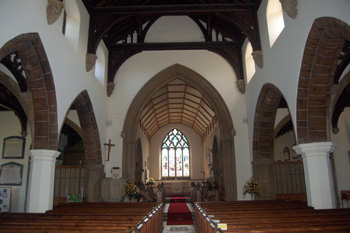
Interior looking east May 2010
The first documented mention of alterations in the church is in 1556 when two bells were removed from the tower by the widow of Robert Burgoyne, who took them to pay off his debts. By 1708 there were five bells, one cast in 1602. An inventory of 1601 noted a clock and a pair of organs.
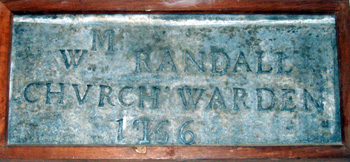
William Randall churchwarden 1756 - inscription in the west tower May 2010
Dated pieces of lead, now in the base of the tower, record repairs to the tower roof and steeple in 1692 and 1756. Bells were recast in 1723, 1733 and 1769 and in 1755 Elizabeth Kingsley obtained a faculty for a burial vault which was used by the Kingsleys and Pyms of Hasells Hall until 1860 [PM2717]. New vaults were created for the Pym and Pearson families in the churchyard in 1888 and 1889 [DSA2/1/197].

Interior looking west May 2010
By 1823 there was a west gallery and the Creed, Lord's prayer and Ten Commandments were painted on a framework under the chancel arch. These were moved elsewhere in the church about three years later. A new organ was installed in 1830 on the west gallery and may have been replaced in 1853 [PM2722]. A bell was recast in 1852.

Detail of the west tower screen May 2010
John Martin (1791-1855) was the librarian of Woburn Abbey. In the years either side of 1850 he wrote a series of articles for the Northamptonshire Mercury on Bedfordshire churches under the pseudonym WA. These are usually pompous, snide and acerbic in equal measure, so dissatisfied was this high churchman with the state in which he found so many of these churches. Saint Swithin's appeared in the edition of 22nd January 1853: "Two dilapidated suare pews, one, if not both, manufactured of wooden work, which had adorned in days gone by, some part of the fabric; perhaps reliques of the screen. An ancient chest in melancholy decay".
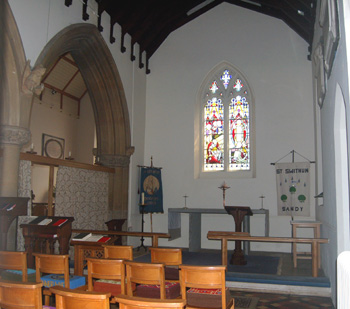
The Lady Chapel in the south transept May 2010
"The nave and aisles open roofs - some open sittings; those that are closed are a motley hotch-potch of the village carpenter's skill and taste. A flying cage in the transept for the accommodation of servants, who are there most ludiscrously suspended over the heads of the congregation. In the churchwardens' seat are some reliques of carving, arranged on a shelf in a manner we have seen ornaments on the mantel-piece of a private residence. Another flying pew abuts the singing loft, but a green curtain cautiously secludes its occupants from their neighbours "who sing". the various siatrcases necessary to reach these dovecotes will immediately suggest the utter unecclesiastical appearance the interior presents; of course the belfry arch is hidden from view".

The font May 2010
The font appears an interesting example, but the pedestal, apparently of a different period, is so bedaubed, as to render any attempt at making out its details, hopeless. The exterior is in tolerable condition. the churchyard locked and overrun with weeds and high grass".
![John Richardson about 1910 [Z1306-99]](/CommunityHistories/Sandy/SandyImages/John Richardson about 1910 [Z1306-99].jpg)
John Richardson about 1910 [Z1306-99]
Rev. John Richardson was rector for fifty five years, from 1858 to 1913 and he quickly set about restoring the church [P9/28/3]. The plans of the architect W. G. Habershon were approved by the Vestry in December 1858 and work began the following year [P9/5/1 and P9/8/1]. The church was completely rebuilt with the exception of the tower. The new church was larger, had a new roof and seats and flamboyant Decorated tracery in the windows and carved heads on the exterior.
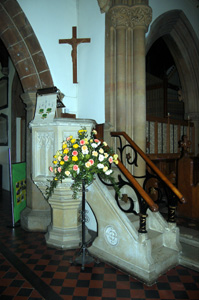
The pulpit May 2010
Some of the momunents were resited and the organ was moved to the new chancel aisle [PM2722]. A new pulpit in Caen stone and a new clock were provided. The church was reopened on 26th April 1860. Sadly, on his way to the event Lord of the Manor Francis Leslie Pym was killed in a train accident.
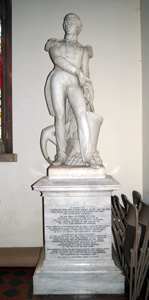
Monument to Sir William Peel May 2010
Following the restoration of the fabric new furnishings were installed. Most obvious of these is the statue of Sir William Peel by William Theed, installed in 1861 in the chancel. It was moved to the south transept in the 1960s. A chancel window was filled with stained glass by Charles Gibbs in memory of Rev. Richardson's wife in the same year.

South transept window detail May 2010
More stained glass windows followed in 1867 and 1881 in the windows of the south and north transepts respectively. A new organ was installed in 1872 and gas heating provided in 1874 [P9/8/1].
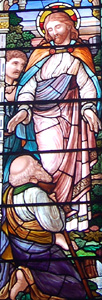
Chancel east window detail May 2010
In 1892 Speaker of the House of Commons, Arthur Wellesley peel presented the stained glass in the east window in memory of his wife. In the same year the bells were re-hung and a new clock set in the tower. A new window in memory of Francis A. K. Foster was placed in the south chapel in 1893 and minor repairs were necessitated by a small fire in the chancel roof in 1894.
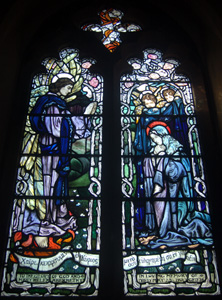
South aisle south wall west window May 2010
The heating system was replaced in 1895 and a wooden screen by Horace Richardson placed in the tower arch in the same year. A stained glass window in the west window of the tower was installed in 1902 as a memorial to Queen Victoria and one in the south aisle by Mary Lowndes in memory of the rector's daughter in the same year. The vestry was enlarged in 1908.
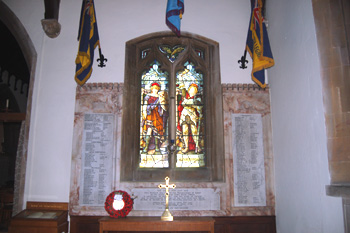
The Great War Roll of Honour on the east end of the south aisle May 2010
The war memorial chapel was created in the south transept after the Great War, in which so many Sandy men were killed. The 1920 memorial is by Maile and Son and the stained glass window by Percy Bacon, who provided another window for the south chapel in 1922.

Lady Chapel east window May 2010
In 1926 two windows in the north aisle were filled with stained glass. In 1951 more glass was introduced in the south chapel and in 1965 in the baptistery. The tower was restored between 1955 and 1957 and in 1961 the south chapel became a Lady Chapel, furnished in memory of Alderman W. G. Braybrooks.

Detail of the west tower screen May 2010
Screens were erected to enclose the organ in 1970. In 1973 a new ringing gallery was constructed in the tower.
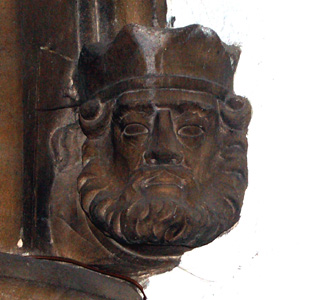 Head on the north side of the north chancel arcade wall May 2010
Head on the north side of the north chancel arcade wall May 2010